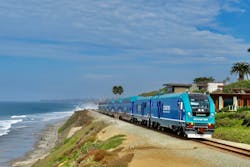HDR chosen by SANDAG to provide environmental clearance and advanced conceptual engineering for LOSSAN Rail Realignment Project
HDR has been recruited by the San Diego Association of Governments (SANDAG) to lead the next phase of work on its critical Los Angeles – San Diego – San Luis Obispo (LOSSAN) Rail Realignment Project. HDR will focus its efforts to maintain the environmental clearance and advanced conceptual engineering of the project.
HDR has worked with SANDAG since 2020 on the San Diego Regional Rail Alternatives Analysis and Conceptual Engineering Study that set the groundwork for the realignment.
HDR, partnering with Mott MacDonald and several other firms, including small businesses, will work with SANDAG to complete the CEQA and NEPA processes in 2026 to support the goal of opening the relocated rail line by 2035.
“This project has been the highlight of my career, with a goal of creating solutions that benefit everyone involved,” said HDR Principal-in-Charge Rob Klovsky. “Not only is it a vital project that will keep our community connected to a national resource, but it’s also a crucial step towards addressing climate change. With the trust and leadership of SANDAG, I am confident we can bring this project to fruition and keep our community connected.”
Within the city of Del Mar, the existing single track sits atop coastal bluffs that are rapidly eroding and threatened by sea level rise. This project will relocate about five miles of the rail line inland, from the bluffs to a double-tracked alignment located primarily in tunnel and through Los Peñasquitos Lagoon in the city of San Diego. This project will enhance safety, reliability and increase capacity along the LOSSAN Rail Corridor.
The project will be the first on the LOSSAN Corridor designed to accommodate train speeds up to 110 mph, paving the way for future speed improvement projects on the corridor.
“This project is all about protecting a critical rail corridor and an economic lifeline for our region,” said HDR Project Manager Lorenzo Garrido. “I am excited to be part of delivering the long-term solution of relocating the tracks from the coastal bluffs that will be a lasting benefit for future generations.”
